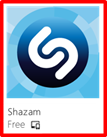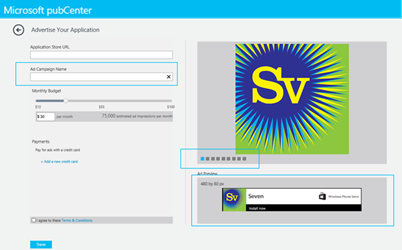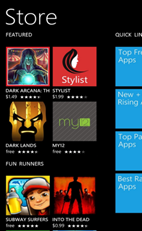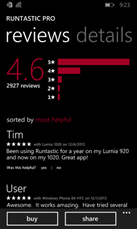Greetings from the 2014 //build/ conference! Platform commonality and consistency across devices and services has been a major theme of the start of the event. For the past several months, the Store team has been driving greater commonality across the Store and Dev Center experience as well, starting in November with the unification of developer accounts and registration. As we said then, we had more to do. Today, I’m sharing the next major step in our journey to maximize developer opportunity and reduce friction with a number of Store enhancements and announcements you’ve asked for.
Increasing opportunity
Universal Windows apps
The biggest new opportunity announced today is universal Windows apps, which now enable you to reach users across the spectrum of Windows devices with optimized app experiences built from one shared project. With universal Windows apps developers can choose to let users download a free app or purchase an app once and install it across all of their compatible Windows devices, as well as allow users to access in-app purchases across their compatible Windows devices. Unified Windows apps will be identified with a new symbol (example below), which will be visible to users in the coming weeks. I want to point out that the decision to charge per-app or per-device for a universal Windows app is entirely up to the developer.
To enable universal Windows apps, we made a number of changes behind the scenes that we think will be a beneficial to all developers. For example, we now offer a single consolidated price tier structure. This change gives Windows developers access to the popular $0.99 and $1.29 (USD) price points to reach new, more price sensitive customer segments. These two price tiers alone represent 55% of all paid transactions on Windows Phone today.
This convergence also required that we consolidate on one revenue sharing model in order to treat transactions equitability across devices, regardless of where first acquired. We will simplify and adopt the industry standard 70/30 revenue share model used by Windows Phone today and phase out the Windows tiered system, effective 12/31/14. This approach gives greater opportunity to all developers and enables faster expansion of revenue-generating features and programs such as expanded carrier billing connections and coverage across more Windows devices. We’re confident that the vast majority of developers will be more successful within the more unified Store infrastructure and policies than they were as part of separate Store programs.
Our investments in carrier billing continue to pay off for developers. When enabled and providing users with a more convenient 1 click way to buy apps and games , total developer paid transactions typically increase by 3x in developed markets and 8x in emerging markets. We now support carrier billing with 57 partners across 36 markets, and I’m pleased to announce today that China Mobile – the largest carrier in the world with 767 million subscribers – and Microsoft have signed an agreement to bring China Mobile billing services to Windows Phone customers in China Mobile’s network within the next few months. Windows Phone will be the first smartphone platform to support direct carrier billing with China Mobile and provides all developers with the ability to reach and more conveniently sell to millions of China Mobile customers.
Another new feature we’re adding gives you more control over the user ratings that can make or break your app. For years you’ve been telling us that you want the ability to reach out to a user who posted a comment or question in a review. Often you can assist or educate the user to improve the experience and hopefully improve your rating in the process. In the next month we’ll begin piloting a feature that will allow developers the opportunity to respond directly to user reviews. We’ll take it slow and will start by inviting a small group of developers to help us test it first.
Advertising is another big focus area. Earlier today, Microsoft Advertising announced the addition of rich media ad units, available in the new ad SDKs for Windows 8.1 and Windows Phone 8 and 8.1 apps. These ad units will provide industry-standard rich media support and are expected to increase eCPM across the Windows platform as the SDK is adopted and advertisers begin to take advantage of the new media. In addition, the pubCenter dashboard UI has been optimized to help you easily track revenue.
Microsoft Advertising today also launched the ability for developers to purchase ads via Pub Center to promote their apps in other apps using Microsoft Advertising ad controls. The initial release uses standard templates for ease of ad creation, and is available for a limited investment in the US only. We’re anxious to see initial results and the lift for participating developers.
Enhanced Store experiences
Windows Phone 8.1 and the Windows 8.1 Update announced by Joe Belfiore today include enhanced Store experiences designed to increase app discoverability and engagement and as a result increase downloads and monetization for you.
With Windows Phone 8.1, the Store will now deliver app updates automatically (enabled on by default), a popular feature for Windows and the best way to ensure your users always have the latest version of your app. In addition, we’ve added app notification history in the new Action Center so users can see notifications from your apps – pinned or not. You’ll also find the remodeled Store UI increases content density and has fewer and flatter UI navigation layers to make it easier for users to find your apps and learn more about them (check out the new details page pictured below). We’ve also made featured and recommended apps more personal, by intelligently filtering out apps users already own. Apps can also now be installed on SD cards, giving users with devices with SD cards the opportunity to download and store even more apps. In all, the Windows Phone 8.1 Store is designed to work harder for you and for app users.
We’ve also substantially improved the Store experience for PC and tablet users as well. A primary Store goal with the Windows 8.1 Update was simple – increase Store discoverability for Desktop users. Customer feedback was clear, that the Windows Store just wasn’t as easy to find for users in the desktop UI. We’re changing this by making the Store and modern apps more discoverable and accessible by placing a Store icon in the taskbar and enabling your apps to be pinned there as well. And just like with Windows Phone, we’re doing more with Windows 8.1 Update to dynamically notify users of activity, including reminders that apps have been installed. In this release, we’re also giving you the opportunity to set and display sale pricing to run your own app promotions.
We have a few more Window 8.1 Store enhancements targeted for release in May that will continue to support the objectives of increasing app discoverability, including a refresh of the Store UI to increase content density, make the popular app Collections and Categories more accessible in the navigation and add a persistent navigation bar across the top of the Store to simplify use. We’ll have more to share on these enhancements in the coming weeks.
Reducing friction
Starting today, we are removing two major points of developer friction and complaints we’ve heard from you. First, we have fully completed the roll-out of a streamlined Windows Phone certification workflow that is reducing app certification and publishing times from an average of 2.5 days to 2-4 hours for both new and updated apps. We are taking the learnings from this roll-out to set plans to streamline the Windows workflow in upcoming months. Second, we are replacing our company vetting process with a new more convenient process for new developers that will reduce vetting time from 10 days to 2 days in most cases.
Next, we have merged our Store developer agreements, creating a single, consistent, and unified agreement that encompasses phone, tablet and PC app submissions. In addition, we’ve separated the application license terms into a separate document to reduce the number of updates we release to you.
Like our agreements, we’ve also made a number of changes to improve your experience with the Dev Center. The first thing you’ll notice is that the MSDN content library has now been consolidated into a single source of guidance and reference. And, knowing you will increasingly publish universal Windows apps, we’ve also consolidated our support team with one source to assist you with all your Windows apps.
A little bit later this month, when Windows Phone Dev Center opens for Windows Phone 8.1 app submissions, you’ll also find a number of improvements you’ve been asking for such as removal of the credit card validation requirements for new accounts, the option to register and renew registration with PayPal, and the ability, for the first time on Windows Phone, to reserve names for your new apps up to 12 months in advance of their release (Note: Existing Windows Phone apps may keep their current display name). However, we will continue to have two Dev Centers with separate app submission flows and dashboards. We’ll tackle that consolidation in a future release.
Finally, in the coming weeks we’ll also offer a Windows Phone 8.1 OS Preview program to ensure you have the new OS available to install to support your build and test efforts. If you haven’t yet taken advantage of the program, I encourage you to learn more in preparation for the release of Windows Phone 8.1.
Opportunities for new and novice developers
We also continue to make investments in resources and tools to help new developers bring their ideas to life. Earlier today, we announced expansion of the popular AppCampus mobile app accelerator program to support all Windows devices, not just Windows Phone. For those of you not familiar with the program, AppCampus is a collaboration between Microsoft, Nokia, and Aalto University, with the goal of providing funding and support to help developers bring their innovation to the Windows platform. If you have a great idea for a Windows platform app or game, submit an online application directly on the AppCampus site. The spring application period closes April 30, 2014.
We also continue making investments to Windows Phone App Studio Beta to address your suggestions and to align with our evolving platform strategy. In the first 8 months of availability, over 400,000 registered users have created over 370,000 app projects in the tool, 20,000 of which have been published to Windows Phone Store. Tomorrow we will add our most requested feature, the ability to create a Windows Phone app and a Windows app in a single project. There are a few other great features coming as part of that release, but I don’t want to give too much away now. You’ll want to visit Windows Phone App Studio Beta tomorrow to see them yourself.
Getting started
I covered a lot of news in this post, all of which will be available at different times over the coming weeks. Given that, I’d like to offer a suggestion on how and when to quickly get started.
|
Today |
Develop unified app experiences and leverage the new platform capabilities across the Windows platform – phone, tablet and PC |
|
|
Need Help? |
Register for a local coding event to polish and complete your current app projects with help from the experts |
|
|
Mid-April |
Install Windows Phone 8.1 OS Preview
|
Test your Windows Phone 8.1 apps on the Preview and submit to Dev Center, where you’ll see the enhancements called out in today’s post |
With the new converged platform and the enhancements we announced today, we believe developing for Windows is even more of a winning proposition. To provide more motivation for you to start developing right away, we’re announcing a contest offering an opportunity to win great prizes (120 in all) – all you need to do is develop a new app for the Windows platform.
Just develop and submit a new app to the Windows Store between now and June 1, 2014. All submissions will be evaluated based on adoption of Windows platform features, originality, quality, and technical excellence. Grand prizes: Best Cross-Platform App, Best Windows 8.1 App, Best Windows Phone 8.1 App, and Best Innovation and Design. Learn more.
Enjoy the rest of the BUILD conference. And if you are not attending in person, we encourage you to tune in to Channel 9 where we broadcast keynotes, top sessions, and interviews live throughout the event (FYI, you can submit questions online). Updates and announcements are posted on the Microsoft News Center. All sessions will be made available on-demand within about 24 hours of presentation time.
You’ll also want to watch this blog closely for more news and information and be sure to follow us on Twitter @windevs.
We’ve listened to your feedback and continue to innovate to enable you do more with your apps, increase your reach and grow your opportunity. And to make it easier than you’ve ever been able to before. Thanks for joining us. We’re just getting started.







